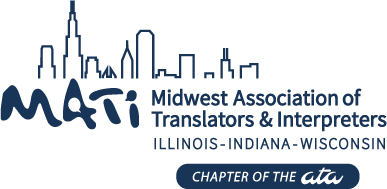Advice on the ATA Certification Sitting
The ATA certification sitting hosted by MATI in Chicago on Friday, September 20 is quickly approaching, so we asked MATI members who have already undergone certification process if they may have any advice to offer those who plan on taking the exam. You’ll find that advice below, from the kinds of reference material to bring to little steps you can take to use your time efficiently during the exam. Good luck!
Preparing for the exam
DO spend the money to take a practice text! Just as each client may have her or his own glossary, style rules, etc., so does the ATA, and by taking a practice exam, you will have a better idea of what the ATA is looking for. For example, there are a number of legitimate approaches for treating hospital names. You could translate the name, leave it in the source language, or include both the source and target. By taking the practice exam, you’ll have an idea of what the ATA prefers. After having been in the business for many years, you know just how important it is to know what your client's expectations are, so you can adequately respond to them. Similarly, even if you have been working as a translator for many years, the insights you gain from the practice exam on types of text, vocabulary, register, etc., will better prepare you to respond to the ATA’s expectations.
-Anonymous
Before the exam, reading texts from the legal, scientific, etc. communities to remind yourself of the styles currently used in those fields may be a good idea.
-Kate Jankowski
I highly recommend taking a practice test or two before the exam because you get written feedback on the practice tests, giving you a good idea of areas of strength and opportunity for improvement. You only receive a pass/fail grade for the official exam and the passing rate is about 20%.
-Sue Couture
What to bring
Thinking that it’s ridiculous to carry so much is no reason to leave any kind of reference material behindundefinedtake a suitcase full of books if you need to. At the very least, candidates should bring good English and target language monolingual dictionaries, a good bilingual dictionary, and one bilingual dictionary in each of the following categories: technical, medical and legal. Those working into either Spanish or Portuguese should bring material related to the new grammar and spelling guidelines of those languages, and candidates should also bring any other reference (like personal glossaries) that they find essential to their daily work.
-Lilian Ramsey
The exam proctor will tell you how much time is left until the end of the exam at certain points, but some people like to know how much time is left all of the time. Many of us would use our cell phones for something like that now, but as no electronic devices are allowed during the exam, digging out and bringing an old watch to the exam might be a good idea.
-Kate Jankowski
I recommend bringing a good general bilingual dictionary along with specialty dictionaries that you have used before and are comfortable with… Having references that are familiar to you saves time, especially if you are writing the translation by hand.
-Sue Couture
Before the exam starts
Set up your books and glossaries around your working area considering the frequency of use (most used, closest to you). Set up your pencils, erasers, and pens in front of you.
-Lilian Ramsey
All of the instructions that the ATA provides answer many questions you may have, so do read them!
-Kate Jankowski
During the exam
Pay attention to the proctor's instructions. Once you open the envelope, don't waste a second. Start reading each passage, and decide which ones you are going to translate. As you read, underline any words that may require research using reference material, and once you have finished reading all of the selected texts, look up all words that need clarification. This method is faster than researching one word at a time.
Be sure to give yourself enough time to read through the whole translation at the end to check for omissions, accuracy, and spelling and punctuation. This is key. And, of course, your handwriting has to be legible.
-Lilian Ramsey
Take the time to ensure that the translated text reads naturally and does not stick too closely to the original.
-Kate Jankowski
If the exam is on paper, I encourage test-takers not to be overly concerned about crossing things out and moving them around. Accurately conveying the intended meaning of the source text is more important than the corrections made during the process, as long as your handwriting is legible.
-Sue Couture
To register for the ATA Certification Sitting to be hosted by MATI or for more information, visit the ATA’s Certification Program webpage.
